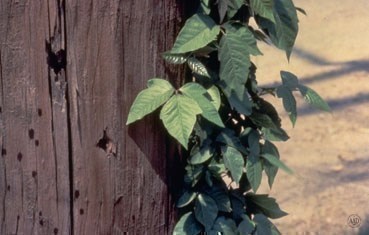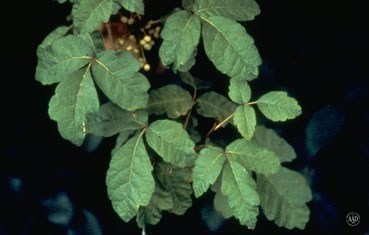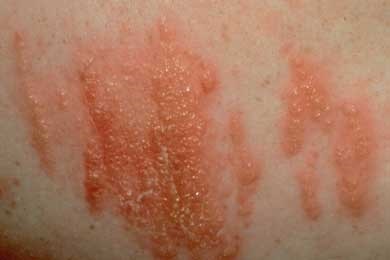This are plants that are a common cause of allergic reactions in the United States. They typically grow in 2 forms, either as a vine (in the East, Midwest, and the South) or as a shrub (in the Northern and Western United States, the Great Lakes region, and in Canada). Each form has 3 leaves; each leaf has 3 leaflets. It is handy to remember the adage “Leaflets three, let it be” when thinking about poison ivy.
Poison Ivy

Poison Oak

The allergic reaction occurs because of urushiol, an oil in the sap of the poison ivy plant. Urushiol is clear or pale yellow; it oozes from any cut or crushed part of the plant (i.e. roots, stems, and leaves) and turns brownish-black upon exposure to air. Most people are allergic to urushiol, such that an itchy, red rash develops upon contact of urushiol with the skin.
How it’s spread: The only way to get the itchy red rash associated with poison ivy is to come in contact with urushiol. This can occur in 3 ways:
-
- If you come directly in contact with the urushiol on the poison ivy plant.
- If you come in contact with anything that has urushiol on it (i.e. clothing, gloves, pet fur, someone else’s skin).
- If you come in contact with the smoke from a burning poison ivy plant (the urushiol becomes airborne in this instance).
If you think you have been exposed to poison ivy get rid of the urushiol as quickly as possible:
-
- Immediately wash all exposed skin areas with cold running water (urushiol penetrates the skin within minutes, so the faster you remove it from the skin, the better off you are).
- Remove all of your clothing and wash your clothing in the washing machine with detergent; you should be careful not to touch rugs or furniture (or anything else in your home) with your contaminated clothing, as that may transfer the urushiol to these items.
- Wash all of your gear (camping, fishing, and the like) that may have also become contaminated, because urushiol can remain active on inanimate objects for several months.
The itchy red rash of poison ivy typically occurs 12 to 48 hours following contact with urushiol. The rash often occurs in a linear arrangement, indicating the way a person brushed up against the poison ivy leaves. There is usually swelling and blistering at the site of the rash. The blisters usually crust over within a few days, but can take as long as 10 to 14 days to heal completely.
If your child has a poison ivy/oak rash that covers more than 10% of the skin surface; is on the hands, face or genitals, he should be seen in our office to assess need for prescription treatment.

How to lessen the itch:
-
- Take a cool shower.
- Soak in a bathtub with baking soda (sprinkle the baking soda right into the bath water) or oatmeal (simply put some oatmeal in a sock and then put the sock into the bath water).
- Apply some calamine lotion.
What medicines are used:
-
- Moderate potency prescription cortisone creams applied twice a day for 2-3 weeks are helpful for less severe, localized reactions (i.e. reactions involving less than 10% of the skin’s surface).
- Oral corticosteroids are typically reserved for reactions involving more than 10% of the skin’s surface, the hands, face, or genitals.
- Oral antihistamines (e.g. Benadryl) can help reduce the sensation of itching, but this is because of their sedating effects, not because they limit the reaction.
Agents with no proven efficacy in treating/healing poison ivy dermatitis (some of these can actually worsen the situation):
-
- Topical antihistamines.
- Topical anesthetics with benzocaine.
- Antibiotic ointment with neomycin or bacitracin (these first three agents can all cause a contact dermatitis).
- Topical pimecrolimus (though this medicine effectively treats inflammatory skin diseases and eczema, it has not been shown to reduce the symptoms of poison ivy dermatitis).
- Ibuprofen (i.e. Advil or Motrin).
- Jewelweed (also known as Impatiens biflora, this can reduce the itching but does not change the duration or severity of poison ivy dermatitis).
Myths debunked:
-
- You CANNOT get poison ivy from someone else unless the person has not washed all of the urushiol off of his/her skin.
- You CAN get poison ivy in the wintertime (because the plants still contain urushiol).
References and Web sites:
-
- Supplement to Contemporary Pediatrics, Compendium on Poison Ivy Dermatitis: The Insidious Plants, the Resulting Lesions, the Treatment Options. Volume 22, No. 1, July 2005.
- American Academy of Dermatology, http://www.aad.org/
- American Contact Dermatitis Society, www.contactderm.org
- Botanical Dermatology Database, bodd.cf.ac.uk
- National Institute for Occupational Safety and Health (NIOSH), www.cdc.gov/niosh/homepage.html
- Information and photos from American Academy of Dermatology Association: https://www.aad.org/public/diseases/itchy-skin/poison-ivy-oak-and-sumac
